Imagine revolutionizing the way we design bridges, spacecraft, and even medical treatments—not in days or weeks but in mere seconds. Thanks to a new artificial intelligence (AI) framework, DIMON. This framework enhances the capacity of personal computers to solve ultra-massive engineering problem that usually requires supercomputers to find solutions. This innovative framework did not stop there but reduced time to just seconds to perform complex calculations and predictions which usually require hours together for a supercomputer.
The US researchers have unveiled a transformative AI solution called DIMON (Diffeomorphic Mapping Operator Learning), which promises to redefine how engineers and scientists tackle complex problems. This innovative framework allows personal computers to solve massive mathematical equations that previously required supercomputers, making advanced modeling accessible and efficient.
Redefining Engineering with AI
DIMON addresses a universal challenge in science and engineering: solving partial differential equations (PDEs). These equations underpin models for real-world systems, predicting how objects behave over time and space. The detailed paper is published in Nature Computational Science. From understanding how cars deform in crashes to assessing the resilience of bridges under stress, these simulations have traditionally been computationally intensive. DIMON changes the game by accelerating these processes thousands of times over.
Natalia Trayanova, a biomedical engineering and medicine professor at Johns Hopkins University, highlights DIMON’s potential: “This is a solution that we think will have generally a massive impact on various fields of engineering because it’s very generic and scalable.” Unlike traditional methods, this framework eliminates the need to recalibrate grids or meshes every time a shape changes, streamlining simulations and optimizing designs efficiently.
How DIMON Works
In standard engineering practices, PDEs are solved by breaking down complex shapes—like airplane wings or human organs—into small, manageable grids. However, every time these shapes change, the grids must be recalculated, a process that is both time-consuming and computationally expensive. DIMON leverages AI to bypass these inefficiencies. Instead of recalculating, it predicts how physical factors such as heat, stress, or motion behave across various geometries based on learned patterns. This capability allows DIMON to handle new shapes swiftly and accurately.
Real-World Applications
Trayanova’s team has already demonstrated the versatility of DIMON by applying it to over 1,000 digital twin models of human hearts. These highly detailed computer models simulate electrical signal propagation through unique heart shapes. Previously, calculating these models took hours on a supercomputer. With DIMON, the same task now takes just 30 seconds on a desktop computer. This dramatic improvement not only enhances efficiency but also enables integration into daily clinical workflows.

By predicting how cardiac arrhythmias develop, researchers can identify patients at risk of sudden cardiac death and recommend treatment plans faster than ever before. Trayanova emphasizes the significance: “The time to calculate the prediction of a heart digital twin is going to decrease from many hours to 30 seconds, allowing us to make it part of the daily clinical workflow.”
Beyond healthcare, DIMON’s applications extend to industries like automotive crash testing, aerospace design, and orthopedic research. Its ability to solve PDEs across multiple geometries without recalibrating grids offers unparalleled speed and scalability.
A Future of Limitless Potential
Minglang Yin, a postdoctoral fellow at Johns Hopkins who developed the DIMON platform, underscores its versatility: “For each problem, DIMON first solves the partial differential equations on a single shape and then maps the solution to multiple new shapes. This shape-shifting ability highlights its tremendous versatility.” Whether it’s optimizing designs for spacecraft or developing safer automotive structures, DIMON’s capacity to adapt across domains is poised to accelerate innovation.
Collaborators from Johns Hopkins, the University of Houston, and Yale University continue to explore DIMON’s potential across diverse fields. By eliminating bottlenecks in computational modeling, this AI framework could democratize access to advanced engineering solutions, enabling researchers and industries worldwide to solve problems with unprecedented speed and precision.
Bridging Innovation and Accessibility
DIMON’s breakthrough lies not just in its technical achievements but in its accessibility. By reducing reliance on supercomputers, it makes cutting-edge modeling tools available to a broader range of users. This democratization could lead to a surge in innovation, empowering smaller institutions and independent researchers to tackle challenges once deemed insurmountable.
As industries and researchers adopt DIMON, the impact on engineering, healthcare, and beyond could be profound. The AI framework is more than a tool—it’s a catalyst for transforming how we understand and interact with the world around us. With the power to reshape multiple fields, DIMON stands at the forefront of a new era in computational problem-solving.

